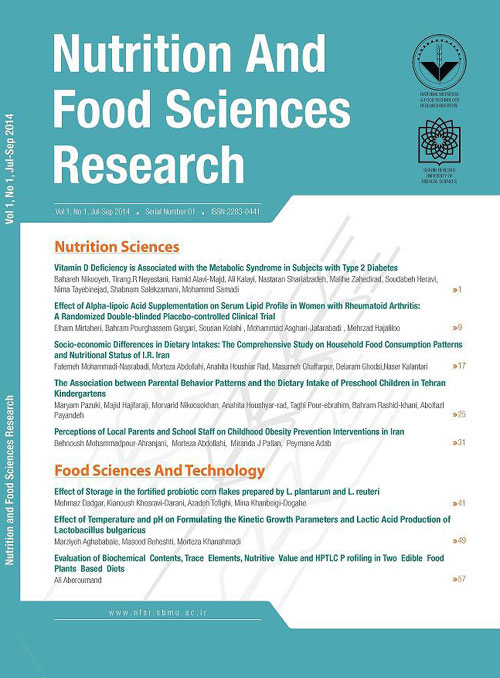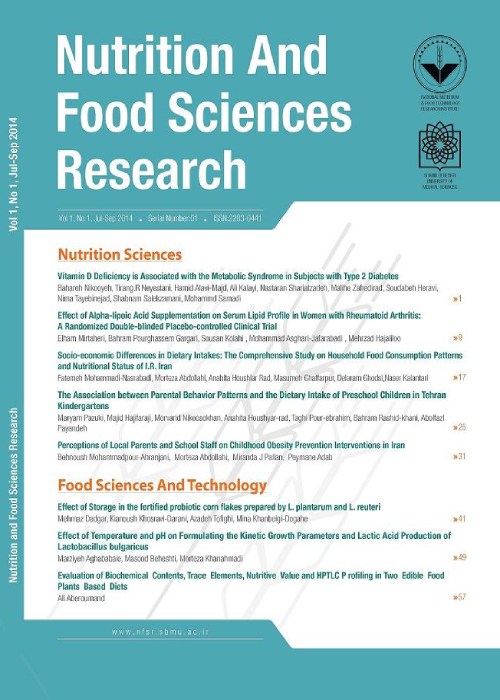فهرست مطالب

Nutrition & Food Technology Research
Volume:9 Issue: 1, Jan-Mar 2022
- تاریخ انتشار: 1400/11/07
- تعداد عناوین: 6
-
-
Pages 1-14
Due to the lack of definite therapy and prevention protocols for Covid-19, nutrition and exercise are considered preventative measures in dealing with the epidemic. Healthy diets, dietary supplements and exercises boost the immune system. These factors can be effective in improving functions of the immune system. The current study investigated immune-enhancing characteristics of exercises, dietary supplements (proteins, vitamins, minerals, oils, coenzyme Q10 (CoQ10), probiotics, ginseng, antioxidants and Chlorella vulgaris) and food additives (titanium dioxide, sodium nitrite, monosodium glutamate, tartrazine, sweeteners and emulsifiers). The current study investigated functions of dietary supplements and exercises in strengthening the immune system, as well as assessing roles of food additives in illness prevention, particularly Covid-19, when combined with a balanced nutrition strategy. Light exercises, healthy lifestyles and nutritional supplements have been shown to boost the immune system.
Keywords: Covid-19, Dietary Supplement, Exercise, Food additive, Immune System -
Pages 15-18Background and Objectives
In recent years, prevalence of hypercholesterolemia has increased, especially in elderly people who are susceptible to increased levels of total cholesterol. Apples include active ingredients that act as antioxidant, anti-proliferation, lipid oxidation inhibitor, anti-hypercholesterol, and weight loss agents. The aim of this study was to investigate how Fuji apple juice affected total cholesterol levels in elderly people.
Materials and MethodsThis study was an experimental study that was carried out on 26 elderly people with a history of hypercholesterolemia, dividing into two major groups using randomized pre post test control group design with randomized controlled trial. The control group (G0) received no medication, while the experimental group (G1) received the Fuji apple juice of 200 ml for 14 days. Paired t-test and independent t-test were used to analyze the results.
ResultsThe mean pre-post G0 total cholesterol increased by 22.38 with, no significant changes (p > 0.05). The mean pre-post G1 total cholesterol decreased by 27.62, suggesting statistically significant changes (p < 0.05).
ConclusionsIn conclusion, use of 200 ml of Fuji apple juice for 14 days decreased total cholesterol levels in hypercholesterolemia elderly people.
Keywords: Elderly People, Fuji Apple Juice, Total Cholesterol -
Pages 19-29Background and Objectives
Sour-cherry seed is one of the waste products of the sour-cherry jam and juice processing. Sour cherries include two valuable wastes, including sour-cherry kernels and seed shells. The two sections have been reviewed and assessed.
Materials and MethodsIn this study, total phenolic compounds, DPPH radical scavenging activity, cellulose, hemicellulose, lignin, BET surface area and density of sour-cherry seed powder were assessed. Cytotoxicity of the methanolic extract of sour-cherry shell was investigated on breast cancer cell lines (MCF-7).
ResultsSour-cherry seed included high quantities of total phenols (27.02 mg GAE/g db). The high-performance liquid chromatography analysis of phenols identified chlorogenic acid 1887.50 (µg/mg), 3,4-dihydroxybenzoic acid 262.30 (µg/mg), quercetin 13.50 (µg/mg) and rutin 58.45 (µg/mg). Results reported 1.490, 36.65, 17.68 and 37.2% db of hemicellulose, cellulose and lignin content, respectively. Sour-cherry and walnut shell methanolic extracts significantly decreased MCF-7 cell growth (p <0.05) in a dose-dependent manner. The methanol extracts of walnut shells and sour-cherry seeds showed cytotoxic activities against MCF-7 cells with IC50 values of 0.47 and 0.97 mg/mL respectively. Kernels included 17% oil and 28.4% protein. Sour-cherry kernel oil included palmitic acid (5.93), stearic acid (3.3), arachidic acid (1.26), oleic acid (45.03), linoleic acid (40.61) and linolenic acid (3.87). Quantity of total phenolic compounds was reported as 6.41 mg gallic acid per gram.
ConclusionsIn conclusion, sour-cherry seed showed good physical characteristics, including potentials to be used in sports drinks, health supplements, pharmaceutical carriers and biosorbents. Preliminary data on characteristics of the sour-cherry seed can provide useful information for potential uses in natural supplements as well as healthy foods.
Keywords: Sour-cherry seed, Phenolic compound, DPPH, Physical characteristics, Bioactive -
Pages 31-40Background and Objectives
Fermented foods may contain acid-tolerant and antibiotic-resistant pathogenic microorganisms. Pathogens can be antagonized by lactic acid bacteria, resulting in improved microbiological safety. This study assessed the antagonistic effects of selected lactic acid bacteria against pathogenic bacteria isolated from a cereal fermented food.
Materials and MethodsEight presumptive staphylococci isolated from a commercially produced cereal fermented beverage on Baird-Parker agar supplemented with tellurite were identified using 16S rRNA sequencing. Acid resistance of the isolates was assessed using acidified media (brain heart infusion broth of pH 3.6 and 1.5% acidity) for 48 h followed by taking plate counts. Antibiotic resistance (19 antibiotics) was assessed using the disk diffusion assay. A spot-on-the-lawn method was used to assess antagonistic effects of Lactobacillus plantarum MNC 21, Lactococcus lactis MNC 24, Weissella confusa MNC 20 and Lactobacillus rhamnosus yoba 2012 against Lysinibacillus macroides, Bacillus subtilis, Enterococcus faecalis and Escherichia coli.
ResultsPresumptive staphylococci were identified as Lysinibacillus macroides (n = 1), Bacillus subtilis (n = 2), Enterococcus faecalis (n = 4) and Escherichia coli (n = 1). These isolates were acid-tolerant (from 6.3 ±0.9 log cfu/mL at 0 h to 3.6 ±0.9 log cfu/mL at 48 h), antibiotic-resistant (multiple antibiotic resistance index of 0.1–0.5) and their growth was inhibited by the lactic acid bacteria (inhibition zone diameters of 14–24 mm).
ConclusionsThe lactic acid bacteria cultures of MNC 20, MNC 21, MNC 24 and Lactobacillus rhamnosus yoba 2012 can be used in various food fermentations to inhibit growth of bacterial pathogens; thus, improving product safety.
Keywords: Antagonism, acid-tolerant, antibiotic-resistant, lactic acid bacteria, Baird-Parker Agar -
Pages 41-48Background and Objectives
Reliable methods are necessary to analyze polychlorinated biphenyls in baby foods, dietary supplements commonly used for children. Nowadays, contamination of food products, mostly derived from agricultural sources, with polychlorinated biphenyls seems inevitable. Of these, cereal-based baby foods are highly important due to the long-term side effects of polychlorinated biphenyls in babies.
Materials and MethodsIn this study, a validated method was developed for the assessment of 12 polychlorinated biphenyls in baby foods based on the solid-phase extraction column sample preparation and gas chromatography-electron capture detectore using PCB 77 and PCB 189 as internal standards. Validation of the method was assessed by the calculated and achieved parameters for linearity, mean recovery, precision, limit of quantification and limit of detection.
ResultsRecoveries at three levels of 0.5, 1 and 2 µg/kg in repeatability and reproducibility studies were in ranges of 78.89–98.32 and 77.28–98.45%, respectively. Linearity was presented as R2 value from 0.9980 to 0.9999, indicating good correlations between the concentrations and peak areas. Limit of quantification and limit of detection were 0.5 and 0.16 (ng/g). Analysis of 30 samples showed that six polychlorinated biphenyls were available in 7% of the samples; of which, 93% were not contaminated with polychlorinated biphenyls. None of the samples contaminated with polychlorinated biphenyls included contamination higher than the maximum residue limit.
ConclusionsValidated methodology was used in polychlorinated biphenyl analysis in various trademarks of cereal-based baby foods commercialized for the Iranian markets. Samples were screened based on the maximum residue limit by the European Union. This method is a simple method and can be carried out in a short time with high accuracy and precision.
Keywords: Analytical procedure, Cereal, GC-ECD, Polychlorinated biphenyls, PCB, Validation -
Pages 49-56Background and Objectives
Ice cream is a probiotic carrier and Bifidobacterium spp. are used to promote health benefits such as vitamin improvement. These bacteria are commonly known as probiotic bacteria. The objective of the present study was to add Japanese loquats, Bifidobacterium lactis and Bifidobacterium bifidum to improve beneficial and nutritional characteristics of ice creams.
Materials and MethodsBacteria were used in various ice cream samples supplemented with Japanese loquat pulps (10, 20 and 30% concentrations). Then, physicochemical (pH, acidity, protein, fat, ash and dry matter), melting, colorimetric (L*, a* and b*), overrun and sensory characteristics were assessed. Bioactive parameters of the ice creams, including phenolic component, antioxidant activity, probiotic bacterial survival and folate value, were investigated within eight weeks.
ResultsAsh, dry matter, melting rate and overrun significantly increased by adding Japanese loquat pulps (p < 0.05). However, no significant effects on pH, acidity, protein and fat of various probiotic ice creams were seen by increasing pulps (p > 0.05). Probiotic ice creams significantly included further phenolic compounds (98.63 mg GAE/100g), antioxidant activity (105.12 mg/100g) and bacterial viability (8.23 log CFU/g) by increasing Japanese loquat pulps. However, these parameters decreased by extending the storage time (p < 0.05). Increases in pulp and storage time significantly increased folates of various samples (p < 0.05).
ConclusionsThe highest functional capacities of the probiotic ice creams belonged to a mixture of Bifidobacterium bifidum, Bifidobacterium lactis and 30% of Japanese loquat pulps.
Keywords: Probiotic, Folat, Phenolic compound, Survival rate


